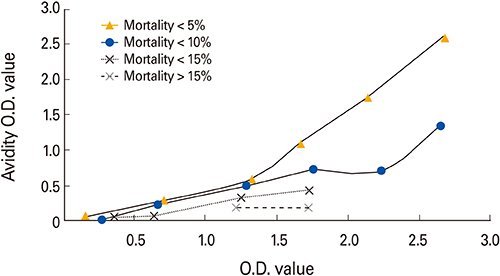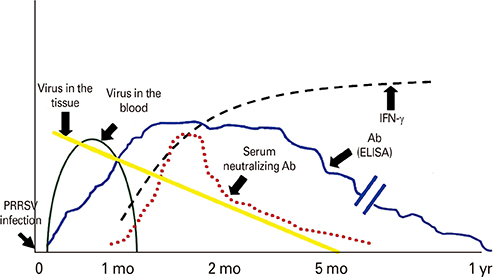Clin Exp Vaccine Res.
2015 Jul;4(2):159-165. 10.7774/cevr.2015.4.2.159.
Porcine reproductive and respiratory syndrome virus vaccine does not fit in classical vaccinology
- Affiliations
-
- 1Department of Pathology, College of Veterinary Medicine, Konkuk University, Seoul, Korea. lyoo@konkuk.ac.kr
- KMID: 1965400
- DOI: http://doi.org/10.7774/cevr.2015.4.2.159
Abstract
- All vaccines are developed to elicit an effective immune response in vaccinated animals such as innate, humoral and cell mediated response to protect animal health. Quality and intensity of the immune responses are differing by characteristics of the vaccine formulation and nature of the infectious agent. Modified live virus vaccines showed advantages over killed vaccines in terms of rapid immune response, duration of the immunity and better cell mediated protection mechanism. The porcine reproductive and respiratory syndrome virus (PRRSV) is relatively newly emerging (1986 in United States, 1990 in Europe) viral pathogen in pigs and tremendous effort has been made to protect pigs from this economically devastating disease such as developing killed, modified live, recombinant protein based and DNA vaccines. However, only cell culture attenuated virus vaccine is practiced with arguably limited efficacy. The PRRSV vaccine did not clear virus from infected pigs nor prevent re-infection of the virus. The vaccine showed very limited innate immune response, low anamnestic immune response and negligible cell mediated immune response. Despite of the current developed scientific technology, there still remain many questions to solve a most important pig disease worldwide.
MeSH Terms
Figure
Reference
-
1. Han M, Yoo D. Modulation of innate immune signaling by nonstructural protein 1 (nsp1) in the family Arteriviridae. Virus Res. 2014; 194:100–109.
Article2. Carter QL, Curiel RE. Interleukin-12 (IL-12) ameliorates the effects of porcine respiratory and reproductive syndrome virus (PRRSV) infection. Vet Immunol Immunopathol. 2005; 107:105–118.
Article3. Charerntantanakul W, Yamkanchoo S, Kasinrerk W. Plasmids expressing porcine interferon gamma up-regulate pro-inflammatory cytokine and co-stimulatory molecule expression which are suppressed by porcine reproductive and respiratory syndrome virus. Vet Immunol Immunopathol. 2013; 153:107–117.
Article4. Meier WA, Husmann RJ, Schnitzlein WM, Osorio FA, Lunney JK, Zuckermann FA. Cytokines and synthetic double-stranded RNA augment the T helper 1 immune response of swine to porcine reproductive and respiratory syndrome virus. Vet Immunol Immunopathol. 2004; 102:299–314.
Article5. Rompato G, Ling E, Chen Z, Van Kruiningen H, Garmendia AE. Positive inductive effect of IL-2 on virus-specific cellular responses elicited by a PRRSV-ORF7 DNA vaccine in swine. Vet Immunol Immunopathol. 2006; 109:151–160.
Article6. Xue Q, Zhao YG, Zhou YJ, et al. Immune responses of swine following DNA immunization with plasmids encoding porcine reproductive and respiratory syndrome virus ORFs 5 and 7, and porcine IL-2 and IFNgamma. Vet Immunol Immunopathol. 2004; 102:291–298.
Article7. Seo SW, Sunwoo SY. PRRSV antibody maturation is time dependent in the infected pigs. In : Proceeding of the 22nd International Pig Veterinary Society Congress; 2012 Jun 10-13; Jeju, Korea. IPVS Press;2012.8. Meier WA, Galeota J, Osorio FA, Husmann RJ, Schnitzlein WM, Zuckermann FA. Gradual development of the interferon-gamma response of swine to porcine reproductive and respiratory syndrome virus infection or vaccination. Virology. 2003; 309:18–31.
Article9. Beura LK, Subramaniam S, Vu HL, Kwon B, Pattnaik AK, Osorio FA. Identification of amino acid residues important for anti-IFN activity of porcine reproductive and respiratory syndrome virus non-structural protein 1. Virology. 2012; 433:431–439.
Article10. Labarque GG, Nauwynck HJ, Van Reeth K, Pensaert MB. Effect of cellular changes and onset of humoral immunity on the replication of porcine reproductive and respiratory syndrome virus in the lungs of pigs. J Gen Virol. 2000; 81:1327–1334.
Article11. Lopez OJ, Osorio FA. Role of neutralizing antibodies in PRRSV protective immunity. Vet Immunol Immunopathol. 2004; 102:155–163.
Article12. Wills RW, Zimmerman JJ, Yoon KJ, et al. Porcine reproductive and respiratory syndrome virus: a persistent infection. Vet Microbiol. 1997; 55:231–240.
Article13. Mulupuri P, Zimmerman JJ, Hermann J, et al. Antigen-specific B-cell responses to porcine reproductive and respiratory syndrome virus infection. J Virol. 2008; 82:358–370.
Article14. Murtaugh MP. Advances in swine immunology help move vaccine technology forward. Vet Immunol Immunopathol. 2014; 159:202–207.
Article15. Barranco I, Gomez-Laguna J, Rodriguez-Gomez IM, et al. Immunohistochemical expression of IL-12, IL-10, IFN-alpha and IFN-gamma in lymphoid organs of porcine reproductive and respiratory syndrome virus-infected pigs. Vet Immunol Immunopathol. 2012; 149:262–271.
Article16. Lopez Fuertes L, Domenech N, Alvarez B, et al. Analysis of cellular immune response in pigs recovered from porcine respiratory and reproductive syndrome infection. Virus Res. 1999; 64:33–42.
Article17. Wesley RD, Lager KM, Kehrli ME Jr. Infection with Porcine reproductive and respiratory syndrome virus stimulates an early gamma interferon response in the serum of pigs. Can J Vet Res. 2006; 70:176–182.18. Xiao Z, Batista L, Dee S, Halbur P, Murtaugh MP. The level of virus-specific T-cell and macrophage recruitment in porcine reproductive and respiratory syndrome virus infection in pigs is independent of virus load. J Virol. 2004; 78:5923–5933.
Article19. Mokhtar H, Eck M, Morgan SB, et al. Proteome-wide screening of the European porcine reproductive and respiratory syndrome virus reveals a broad range of T cell antigen reactivity. Vaccine. 2014; 32:6828–6837.
Article20. Dotti S, Guadagnini G, Salvini F, et al. Time-course of antibody and cell-mediated immune responses to porcine reproductive and respiratory syndrome virus under field conditions. Res Vet Sci. 2013; 94:510–517.
Article21. Chung HK, Chae C. Expression of interleukin-10 and interleukin-12 in piglets experimentally infected with porcine reproductive and respiratory syndrome virus (PRRSV). J Comp Pathol. 2003; 129:205–212.
Article22. Wongyanin P, Buranapraditkun S, Chokeshai-Usaha K, Thanawonguwech R, Suradhat S. Induction of inducible CD4+CD25+Foxp3+ regulatory T lymphocytes by porcine reproductive and respiratory syndrome virus (PRRSV). Vet Immunol Immunopathol. 2010; 133:170–182.
Article
- Full Text Links
- Actions
-
Cited
- CITED
-
- Close
- Share
- Similar articles
-
- Augmented immune responses in pigs immunized with an inactivated porcine reproductive and respiratory syndrome virus containing the deglycosylated glycoprotein 5 under field conditions
- Evaluation of the efficacy of an attenuated live vaccine based on virulent porcine reproductive and respiratory syndrome virus 2 in young pigs
- Intracellular Localization of the Porcine Reproductive and Respiratory Syndrome Virus Nucleocapsid Protein
- Porcine ear necrosis syndrome by coinfection of porcine reproductive and respiratory syndrome virus and Staphylococcus hyicus
- Prevalence of porcine reproductive and respiratory syndrome virus, porcine circovirus type 2 and porcine parvovirus from aborted fetuses and pigs with respiratory problems in Korea




